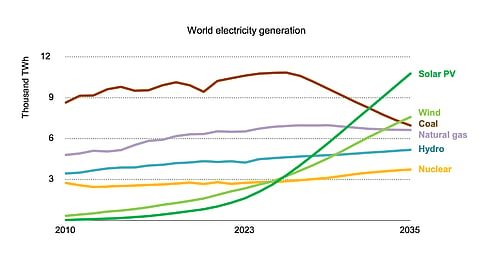

IEA’s WEO 2024 says geopolitical risks and regional conflicts will disrupt global energy supply chains
Cost-effective clean energy technologies can help reduce this dependence as demand further grows
There is a need to watch out for a concentration of supply chains as these can again lead to geopolitical risks
Clean energy technologies also have a greatly reduced exposure to the vagaries of commodity markets and lasting benefits for people and the planet
Having witnessed the Age of Coal and the Age of Oil, the world is now entering the ‘Age of Electricity’ that will increasingly be based on clean energy sources; however, the path there is fraught with regional conflicts and geopolitical strains, says the International Energy Agency (IEA) in its annual flagship report World Energy Outlook 2024 or WEO 2024.
It specifically points to the growing tensions in the Middle East region, which is a major supplier of the world’s conventional fuels, and the continued conflict between Russia and Ukraine. In such a scenario, clean sources of electricity with a well-distributed supply chain can reduce this dependence on global supply chains, while bringing in energy self-sufficiency.
Under the current policies, together with nuclear power, low-emission sources are set to generate more than half of the world’s electricity before 2030. Renewable power generation capacity rises from 4.25 TW today to nearly 10 TW by the end of this decade. The scope is much higher thanks to the rapidly growing demand due to existing uses such as cooling, and upcoming electric mobility and data centers.
By the early 2030s, China’s solar power generation alone could exceed the total electricity demand for the US today.
Solar PV manufacturing capacity of 1,150 GW/year today alone is enough to ensure the deployment of almost 3x that in 2023. By the end of this decade, it is expected to expand to 1,550 GW/year.
According to the report, “Existing solar PV module manufacturing capacities are more than sufficient to produce over 900 GW of solar PV modules, which is the level of capacity additions required in the NZE Scenario by 2030; announcements of planned new capacity would increase this to almost 1,400 GW, or more than 50% above the NZE Scenario level, assuming that these plans proceed.”
Analysts believe that if the manufacturing overcapacity in the solar PV industry persists, it may lead to even faster solar PV growth, especially in emerging markets and developing economies, despite challenging financing conditions.
Cost-effective clean technologies have a greatly reduced exposure to the vagaries of commodity markets and lasting benefits for people and the planet.
Yet, the deployment of clean energy technologies is far from uniform across technologies and markets, according to the IEA. Under the report’s stated policies scenario (STEPS), current policy settings put the world on course for a rise of 2.4°C in global average temperatures by 2100, whereas the demand for all 3 fossil fuels – coal, oil and gas – is still projected to peak by the end of the decade.
“In the second half of this decade, the prospect of more ample – or even surplus – supplies of oil and natural gas, depending on how geopolitical tensions evolve, would move us into a very different energy world from the one we have experienced in recent years during the global energy crisis,” said IEA Executive Director Fatih Birol.
He pointed out the challenges related to the concentration of global supply chains for clean energy technologies, primarily in China. Right from investment, fossil fuel demand, electricity consumption, renewable energy deployment, electric vehicle (EV) market, or clean technology manufacturing, everything is essentially a ‘China story’, said Birol.
The report lists the ‘new energy security risks’ in clean energy which the policymakers need to pay attention to including high financing costs, and project risks limiting their spread, especially in developing economies. More help, thus it recommends, needs to be provided to poorer countries.
The complete report is available on the IEA’s website for free download.
Reacting to the report’s findings, Greenpeace International’s Global Climate Politics Expert, Tracy Carty said, “The action we take in the next two years will shape how much climate-driven destruction we can avoid over the next two decades, and far beyond,” and added, “Rich governments committing to an ambitious new climate finance goal at COP29 is also essential to bridge the urgent and growing gap in funding to developing countries to scale up renewables and phase out fossil fuels.”
